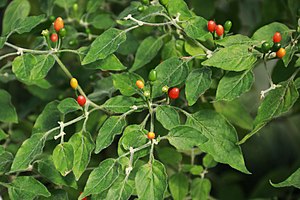Capsicum praetermissum
| Capsicum praetermissum | ||||||||||||
|---|---|---|---|---|---|---|---|---|---|---|---|---|

Capsicum praetermissum |
||||||||||||
| Systematics | ||||||||||||
|
||||||||||||
| Scientific name | ||||||||||||
| Capsicum praetermissum | ||||||||||||
| Hoarse & PGSm. |
Capsicum praetermissum is a plant from the genus of the pepper ( Capsicum ) in the family of the nightshade family . It is considered one of the wild forms of this genus, but is occasionallyassigned tothe species Capsicum baccatum as Capsicum baccatum var. Praetermissum .
The plant comes from the south of Brazil , where it can still be found growing wild today. Fruits collected from these plants are also often available for purchase in local markets.
description
Capsicum praetermissum is an upright shrub with a height of up to 1.5 m, the shoot is sparsely hairy, especially in the lower part of the plant glabrous. The leaves stand on about 3.5 cm long petioles, are about 8 cm long and 6.3 cm wide, pointed towards the front. The hair on the leaves is sparse to dense, but can also be tomentose.
The upright flower stalks in groups of two to three are 1.2 cm long. The calyx is about 1.5 mm long and has five linear-lanceolate calyx teeth with a length of 1 mm. The corolla is radial symmetry and has a diameter of 1.2 to 1.5 cm. The corolla lobes are bordered in purple or purple, at the base there are golden yellow spots. The fine stamens are white and 2 mm long. The anthers are yellow and 1.5 mm long.
The fruits are red, almost egg-shaped berries that are 1 cm wide and 7 mm long. The seeds are pale yellow.
Botanical history
The species was first described in 1958 by Charles B. Heiser Jr. and Paul G. Smith . The type specimen was already collected in 1930 by Ynes Mexia in the Brazilian state of Minas Gerais .
See also
swell
- ^ A b Charles B. Heiser, Jr. and Paul G. Smith: New Species of Capsicum from South America. In: Brittonia , Volume 10, Number 4, October 1958, pp. 194-201. doi : 10.2307 / 2804950